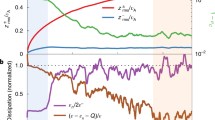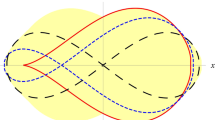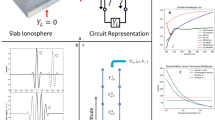Abstract
EXPERIMENTAL results1 show that the attenuation rate of extremely-low frequency radio waves decreases with decreasing-frequency in the range from a few kc/s to about 70 c/s, below which it appears to increase again. The experimental results, however, are not yet fully confirmed. Moreover, theoretical work to date has given no indication that this behaviour would be expected. It has been suggested1, however, that it might be possible to explain the observations by considering a stratified ionosphere consisting of three homogeneous layers having different conductivities. Although a two-layer model was considered, no calculations have so far been given for the more complicated case.
This is a preview of subscription content, access via your institution
Access options
Subscribe to this journal
Receive 51 print issues and online access
$199.00 per year
only $3.90 per issue
Buy this article
- Purchase on Springer Link
- Instant access to full article PDF
Prices may be subject to local taxes which are calculated during checkout
Similar content being viewed by others
References
Jean, A. G., Murphy, A. C., Wait, J. R., and Wasmundt, D. F., J. Res. Nat. Bur. Stand., 65D, 475 (1961).
Bremmer, H., Handbuch der Physik, 16 (Springer-Verlag, 1958).
Burman, R., and Gould, R. N., J. Atmos. Terr. Phys. (in the press).
Wait, J. R., J. Res. Nat. Bur. Stand., 64D, 387 (1960).
Author information
Authors and Affiliations
Rights and permissions
About this article
Cite this article
BURMAN, R., GOULD, R. Extremely Low-frequency Radio Propagation in an Inhomogeneous Ionosphere. Nature 199, 581–582 (1963). https://doi.org/10.1038/199581a0
Issue Date:
DOI: https://doi.org/10.1038/199581a0
Comments
By submitting a comment you agree to abide by our Terms and Community Guidelines. If you find something abusive or that does not comply with our terms or guidelines please flag it as inappropriate.



